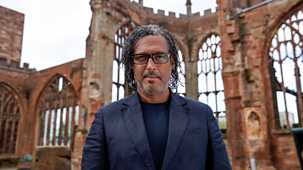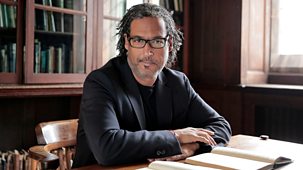
Series 1: 1. The Making of Britain
Historian David Olusoga starts the story of Union in the 17th Century, an era of defined by deep religious divisions between Protestant and\nCatholic.\n\nIn 1603 King James VI of Scotland became King James I of England. David follows in the King’s footsteps to Newcastle, where Scotland and\nEngland, once bitter enemies, were now united under a shared monarch and a shared Protestant faith. The King’s ambition was to forge an even\ncloser relationship between the two kingdoms and join them together in a political union - a proposition which was highly unpopular in some\nquarters. \n\nOpposition to James’s plan came from an unexpected place – English MPs who were fearful that their nation would face a “deluge of Scots” if the kingdoms were united. However, there was support from Wales which was already part of an ancient union with England. David travels to Caernarfon Castle, one of a number of huge fortifications built in the 13th Century following the bloody conquest of Wales by the English King Edward I, after which the Welsh elite were persuaded to set aside their historic differences and accept annexation by England. King James was also responsible for a flag which would ultimately be reimagined as one of the great icons of Britishness – the Union flag. \n\nDavid uncovers the original drawings, which attempted to combine the English and Scottish flags to create a symbol for the new state the King hoped to create, Britain.\n\nWhile the Westminster Parliament had rejected the idea of a political union between England and Scotland there was one place where Britishness as an identity was being forged. In 1610 a plan to colonise the north of Ireland with English and Scottish settlers began – the scheme known as the Plantation of Ulster.\n\nDavid traces the fortunes of the Blennerhasset family from Norfolk, one of these ‘planter’ families who came to settle land near Lough Erne in what is now County Fermanagh. In archives at Trinity College Dublin, David finds evidence in written accounts, learning how planter families were instructed by the English Government to build fortifications and keep weapons to prevent attacks from the indigenous Irish Catholic population whose lands they had taken. David visits the ruins of the Blennerhasset family’s castles and with historian Jane Ohlmeyer discovers what happened to them when the Irish Catholic population rose up in rebellion in 1641. \n\nThe horror of the bloodshed that followed was documented in a collection of accounts known as the Depositions which were later deployed as anti-Catholic propaganda. They helped to foment even further violence, and after a series of bloody battles and atrocities perpetrated by both sides, the rebels were eventually defeated and British control over Ireland re-established. \n\nThe tensions between Catholics and Protestants that emerged in these years were to continue to fester and the legacy of the Plantation of Ulster continues to shape divisions in the north of Ireland today.\n\nDavid next travels to London to tell the story of William Patterson, a Scottish financier who helped establish the Bank of England in 1696.\nPatterson also helped devise an ambitious plan to establish a new Scottish colony overseas, which he hoped would be the beginning of a Scottish Empire to rival that of England. The plan was bankrolled by thousands of ordinary Scots who funded it through public subscription. David travels to the site of the colony – the Darien peninsular in Panama – where over a thousand colonists – including Patterson - arrived in 1699, ready to establish their new community.\n\nBut here disaster struck, as hundreds died of disease. The colony was eventually abandoned and the surviving colonists, who included William Patterson, returned to Scotland. \n\nThe consequences for the failure of the Darien Scheme were devastating for Scotland. An estimated 40 percent of the country’s liquid wealth had been invested in this venture and its collapse pushed the country to near bankruptcy. This led Patterson and many others to revisit an idea suggested by King James at the start of the century – a union with England. \n\nDespite vehement opposition from some, the plan was enacted, the Scottish parliament was closed, and political control of Scotland moved to Westminster. With the Acts of Union, a new nation, Great Britain, was formed in 1707.
Source: BBC 2
Most recent episodes of Union with David Olusoga
Union With David Olusoga
Series 1: 4. Union And Disunion
The 20th century sees partition in Ireland. A sense of national unity emerges in the aftermath of the Second World War, but economic challenges in the 1970s create new divisions ...
29-12-2023
BBC 2
Union With David Olusoga
Series 1: 3. The Two Nations
In the 19th century, the union of Great Britain and Ireland appeared to be secure and powerful. Yet beneath the surface were deep divisions between rich and poor, and social cla ...
25-10-2023
BBC 2
Union With David Olusoga
Series 1: 2. Creating Britishness
David Olusoga reveals how, in the 18th century, a new British identity was forged in the face of multiple threats from within - including the Jacobite rebellions in Scotland and ...
18-10-2023
BBC 2
Union With David Olusoga
Series 1: 1. The Making Of Britain
Historian David Olusoga starts the story of Union in the 17th Century, an era of defined by deep religious divisions between Protestant and\nCatholic.\n\nIn 1603 King James VI o ...
11-10-2023
BBC 2
Most popular episodes of Union with David Olusoga
Union With David Olusoga
Series 1: 1. The Making Of Britain
Historian David Olusoga starts the story of Union in the 17th Century, an era of defined by deep religious divisions between Protestant and\nCatholic.\n\nIn 1603 King James VI o ...
11-10-2023
BBC 2
Union With David Olusoga
Series 1: 2. Creating Britishness
David Olusoga reveals how, in the 18th century, a new British identity was forged in the face of multiple threats from within - including the Jacobite rebellions in Scotland and ...
18-10-2023
BBC 2
Union With David Olusoga
Series 1: 3. The Two Nations
In the 19th century, the union of Great Britain and Ireland appeared to be secure and powerful. Yet beneath the surface were deep divisions between rich and poor, and social cla ...
25-10-2023
BBC 2
Union With David Olusoga
Series 1: 4. Union And Disunion
The 20th century sees partition in Ireland. A sense of national unity emerges in the aftermath of the Second World War, but economic challenges in the 1970s create new divisions ...
29-12-2023
BBC 2




